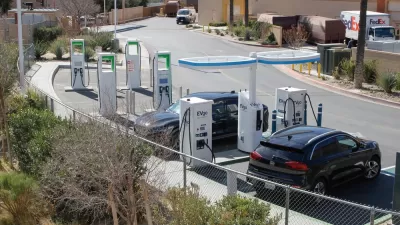The true cost of vehicle and road use is not reflected in the price drivers pay.

It is widely understood that there are enormous and growing negative externalities associated with motor vehicle use, in the form of pollution, sprawl, and public safety, to name a few. But all too often the American narrative on gas prices is that they are too high. External costs can be hard to measure and challenging to accurately convey to a user group. Perhaps more commonly understood is that the direct costs of vehicle use—namely, the maintenance and construction of roads—is covered by gasoline taxes. A new report from the Frontier Group—in partnership with the U.S. PIRG Education Fund—cracks this myth wide open. The price paid by car drivers does not come close to covering even the direct costs of road use.
"Puncturing the widely held myth that cars pay their own way makes this report required reading for those thinking about transportation finance reform," writes Joe Cortwright.
Federal subsidies to the highway administration system are enormous. "Since 1947, the amount of money spent on highways, roads and streets has exceeded the amount raised through gasoline taxes and other so-called 'user fees' by $600 billion (2005 dollars), representing a massive transfer of general government funds to highways," according to the report.
The price mechanism for road use is not based on a user fee because gas taxes, which are often referred to as user fees, are not necessarily directed to the actual roads the driver uses. In some cases, states subsidize federal highways, in other cases, the federal government has redirected gas tax revenues to pork-barrel infrastructure projects, and with the exception of tolled roads, drivers pay rates based on mileage, not the actual roads they use.
Cortwright argues that if gas prices and other vehicle use fees reflected the true cost of use, single-occupant vehicle use would decrease, as drivers would opt for cheaper forms of travel.
"These facts put the widely agreed proposition that increasing the gas tax is politically impossible in a new light: What it really signals is car users don’t value the road system highly enough to pay for the cost of operating and maintaining it. Road users will make use of roads, especially new ones, but only if their cost of construction is subsidized by others."
FULL STORY: Beyond gas: The price (of driving) is wrong

Trump Administration Could Effectively End Housing Voucher Program
Federal officials are eyeing major cuts to the Section 8 program that helps millions of low-income households pay rent.

Planetizen Federal Action Tracker
A weekly monitor of how Trump’s orders and actions are impacting planners and planning in America.

The 120 Year Old Tiny Home Villages That Sheltered San Francisco’s Earthquake Refugees
More than a century ago, San Francisco mobilized to house thousands of residents displaced by the 1906 earthquake. Could their strategy offer a model for the present?

Alabama School Forestry Initiative Brings Trees to Schoolyards
Trees can improve physical and mental health for students and commnity members.

NYC Outdoor Dining Could Get a Re-Do
The city council is considering making the al fresco dining program year-round to address cost concerns from small businesses.

HSR Reaches Key Settlement in Northern California City
The state’s high-speed rail authority reached an agreement with Millbrae, a key city on the train’s proposed route to San Francisco.
Urban Design for Planners 1: Software Tools
This six-course series explores essential urban design concepts using open source software and equips planners with the tools they need to participate fully in the urban design process.
Planning for Universal Design
Learn the tools for implementing Universal Design in planning regulations.
Ada County Highway District
Clanton & Associates, Inc.
Jessamine County Fiscal Court
Institute for Housing and Urban Development Studies (IHS)
City of Grandview
Harvard GSD Executive Education
Toledo-Lucas County Plan Commissions
Salt Lake City
NYU Wagner Graduate School of Public Service




























